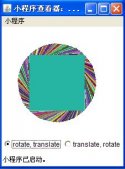前言
作為Java開(kāi)發(fā)者,我們每天都會(huì)創(chuàng)建大量的對(duì)象,但是,我們總是使用管理依賴(lài)系統(tǒng)(如Spring框架)來(lái)創(chuàng)建這些對(duì)象。其實(shí)還有其他方法可以創(chuàng)建對(duì)象,在接下來(lái)的文章中我會(huì)進(jìn)行詳細(xì)介紹。
1.使用new關(guān)鍵字
這是最常見(jiàn)的創(chuàng)建對(duì)象的方法,并且也非常簡(jiǎn)單。通過(guò)使用這種方法我們可以調(diào)用任何我們需要調(diào)用的構(gòu)造函數(shù)。
|
1
2
3
4
|
Employee emp1 = new Employee();0: new #19 // class org/programming/mitra/exercises/Employee 3: dup 4: invokespecial #21 // Method org/programming/mitra/exercises/Employee."":()V |
2.使用class類(lèi)的newInstance方法
我們也可以使用class類(lèi)的newInstance方法來(lái)創(chuàng)建對(duì)象。此newInstance方法調(diào)用無(wú)參構(gòu)造函數(shù)以創(chuàng)建對(duì)象。
我們可以通過(guò)newInstance() 用以下方式創(chuàng)建對(duì)象:
|
1
|
Employee emp2 = (Employee) Class.forName("org.programming.mitra.exercises.Employee").newInstance(); |
或者
|
1
2
|
Employee emp2 = Employee.class.newInstance();51: invokevirtual #70 // Method java/lang/Class.newInstance:()Ljava/lang/Object; |
3.使用構(gòu)造函數(shù)類(lèi)的 newInstance方法
與使用class類(lèi)的newInstance方法相似,java.lang.reflect.Constructor類(lèi)中有一個(gè)可以用來(lái)創(chuàng)建對(duì)象的newInstance()函數(shù)方法。通過(guò)使用這個(gè)newInstance方法我們也可以調(diào)用參數(shù)化構(gòu)造函數(shù)和私有構(gòu)造函數(shù)。
|
1
2
3
|
Constructor<Employee> constructor = Employee.class.getConstructor();Employee emp3 = constructor.newInstance();111: invokevirtual #80 // Method java/lang/reflect/Constructor.newInstance:([Ljava/lang/Object;)Ljava/lang/Object; |
這些 newInstance() 方法被認(rèn)為是創(chuàng)建對(duì)象的反射手段。實(shí)際上,內(nèi)部類(lèi)的newInstance()方法使用構(gòu)造函數(shù)類(lèi)的 newInstance() 方法。這就是為什么后者是首選并且使用不同的框架如Spring, Hibernate, Struts等。
4.使用clone方法
實(shí)際上無(wú)論何時(shí)我們調(diào)用clone方法,JAVA虛擬機(jī)都為我們創(chuàng)建了一個(gè)新的對(duì)象并且復(fù)制了之前對(duì)象的內(nèi)容到這個(gè)新的對(duì)象中。使用 clone方法創(chuàng)建對(duì)象不會(huì)調(diào)用任何構(gòu)造函數(shù)。
為了在對(duì)象中使用clone()方法,我們需要在其中實(shí)現(xiàn)可克隆類(lèi)型并定義clone方法。
|
1
2
|
Employee emp4 = (Employee) emp3.clone();162: invokevirtual #87 // Method org/programming/mitra/exercises/Employee.clone ()Ljava/lang/Object; |
5.使用反序列化
無(wú)論何時(shí)我們對(duì)一個(gè)對(duì)象進(jìn)行序列化和反序列化,JAVA虛擬機(jī)都會(huì)為我們創(chuàng)建一個(gè)單獨(dú)的對(duì)象。在反序列化中,JAVA虛擬機(jī)不會(huì)使用任何構(gòu)造函數(shù)來(lái)創(chuàng)建對(duì)象。
對(duì)一個(gè)對(duì)象進(jìn)行序列化需要我們?cè)陬?lèi)中實(shí)現(xiàn)可序列化的接口。
|
1
2
3
|
ObjectInputStream in = new ObjectInputStream(new FileInputStream("data.obj"));Employee emp5 = (Employee) in.readObject();261: invokevirtual #118 // Method java/io/ObjectInputStream.readObject:()Ljava/lang/Object; |
正如我們?cè)谝陨系淖止?jié)代碼片段中所看到的,除第一種被轉(zhuǎn)換為一個(gè)新的函數(shù)和一個(gè) invokespecial 指令以外,其它4種方法都被調(diào)用并轉(zhuǎn)換為invokevirtual。
示例
讓我們來(lái)看看準(zhǔn)備創(chuàng)建對(duì)象的 Employee 類(lèi):
|
1
2
3
4
5
6
7
8
9
10
11
12
13
14
15
16
17
18
19
20
21
22
23
24
25
26
27
28
29
30
31
32
33
34
35
36
37
38
39
40
41
42
43
44
45
46
47
48
49
50
|
class Employee implements Cloneable, Serializable { private static final long serialVersionUID = 1L; private String name; public Employee() { System.out.println("Employee Constructor Called..."); } public String getName() { return name; } public void setName(String name) { this.name = name; } @Override public int hashCode() { final int prime = 31; int result = 1; result = prime * result + ((name == null) ? 0 : name.hashCode()); return result; } @Override public boolean equals(Object obj) { if (this == obj) return true; if (obj == null) return false; if (getClass() != obj.getClass()) return false; Employee other = (Employee) obj; if (name == null) { if (other.name != null) return false; } else if (!name.equals(other.name)) return false; return true; } @Override public String toString() { return "Employee [name=" + name + "]"; } @Override public Object clone() { Object obj = null; try { obj = super.clone(); } catch (CloneNotSupportedException e) { e.printStackTrace(); } return obj; }} |
在下面的Java程序中我們用5種方式來(lái)創(chuàng)建 Employee對(duì)象。
|
1
2
3
4
5
6
7
8
9
10
11
12
13
14
15
16
17
18
19
20
21
22
23
24
25
26
27
28
29
30
31
32
33
34
35
|
public class ObjectCreation { public static void main(String... args) throws Exception { // By using new keyword Employee emp1 = new Employee(); emp1.setName("Naresh"); System.out.println(emp1 + ", hashcode : " + emp1.hashCode()); // By using Class class's newInstance() method Employee emp2 = (Employee) Class.forName("org.programming.mitra.exercises.Employee") .newInstance(); // Or we can simply do this // Employee emp2 = Employee.class.newInstance(); emp2.setName("Rishi"); System.out.println(emp2 + ", hashcode : " + emp2.hashCode()); // By using Constructor class's newInstance() method Constructor<Employee> constructor = Employee.class.getConstructor(); Employee emp3 = constructor.newInstance(); emp3.setName("Yogesh"); System.out.println(emp3 + ", hashcode : " + emp3.hashCode()); // By using clone() method Employee emp4 = (Employee) emp3.clone(); emp4.setName("Atul"); System.out.println(emp4 + ", hashcode : " + emp4.hashCode()); // By using Deserialization // Serialization ObjectOutputStream out = new ObjectOutputStream(new FileOutputStream("data.obj")); out.writeObject(emp4); out.close(); //Deserialization ObjectInputStream in = new ObjectInputStream(new FileInputStream("data.obj")); Employee emp5 = (Employee) in.readObject(); in.close(); emp5.setName("Akash"); System.out.println(emp5 + ", hashcode : " + emp5.hashCode()); }} |
此程序輸出結(jié)果如下:
|
1
2
3
4
5
6
7
8
|
Employee Constructor Called...Employee [name=Naresh], hashcode : -1968815046Employee Constructor Called...Employee [name=Rishi], hashcode : 78970652Employee Constructor Called...Employee [name=Yogesh], hashcode : -1641292792Employee [name=Atul], hashcode : 2051657Employee [name=Akash], hashcode : 63313419 |
以上內(nèi)容是關(guān)于java創(chuàng)建對(duì)象的5種不同方法,希望給大家學(xué)習(xí)java時(shí)有所幫助。也謝謝大家對(duì)服務(wù)器之家的支持。













